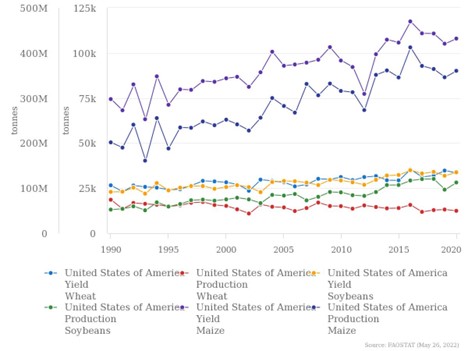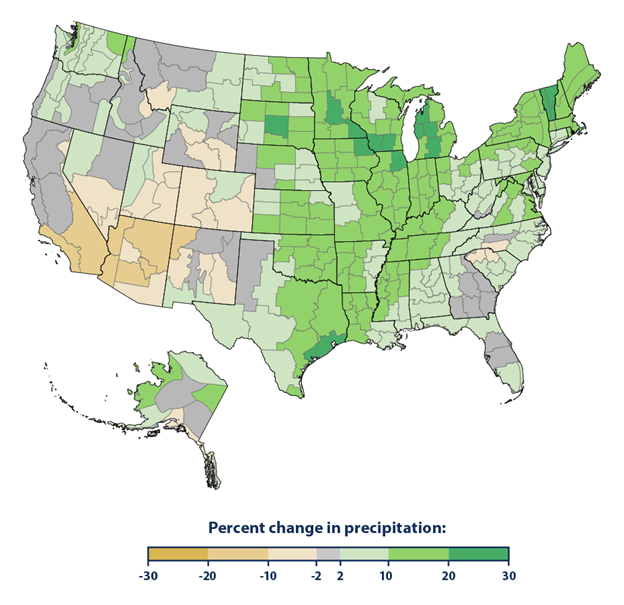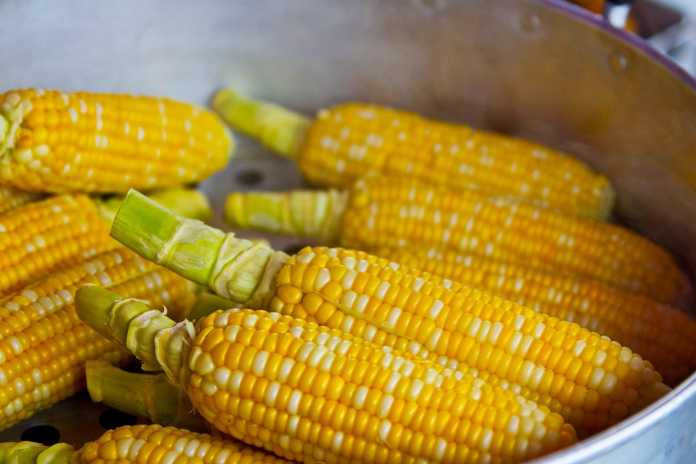An article in the online science publication Phys.org says that unless significant adaptations are made, America’s “corn belt” won’t be able to sustain crop production by 2100 because of climate change. This claim is based on flawed computer models and is likely mistaken. Data show higher carbon dioxide concentrations and modest warming have significantly boosted crop production, not just for corn, but for the other staple food crops discussed in the Phys.org article. Botany and agronomy explain why and there is no reason to believe that further modest warming won’t continue to favor crop production in the America’s heartland.
The Phys.org article, titled “Climate change on course to hit US Corn Belt especially hard, study finds,” takes at face value claims made by researchers at Emory University that climate change will make vast portions of America’s breadbasket, or as Phys.org labeled it America’s corn belt, unsuitable for crop production by 2100.
“Climate change will make the U.S. Corn Belt unsuitable for cultivating corn by 2100 without major technological advances in agricultural practices, an Emory University study finds,” writes Phys.org. “Environmental Research Letters [ERL] published the research, which adds to the evidence that significant agricultural adaptation will be necessary and inevitable in the Central and Eastern United States.
“‘Climate change is happening, and it will continue to shift U.S. cultivation geographies strongly north,’ said Emily Burchfield, author of the study and assistant professor in Emory’s Department of Environmental Sciences.”
Data indicates Burchfield’s prognostication is likely wrong. The ERL study’s claims are based solely on computer model projections of future climate conditions. Yet, as discussed on Climate Realism, here, here, and here, for example, scientists are increasingly acknowledging computer models are seriously flawed. Their hindcasts fail to accurately reflect past and present temperatures and climate conditions, and their future projections are way “too hot.” Worse still, climate models’ performances have worsened over time. Newer models perform worse than older generations of models when their projections are compared to actual climate conditions.
Data show that as the planet has modestly warmed global crop production has soared; U.S. crop production is no exception. The ERL study looks at three main food crops which dominate Mid-Western farm fields: corn, soybeans, and wheat. Data from the United Nations Food and Agriculture Organization show that between 1990 and 2020, the period which climate alarmists commonly assert was the warmest period on record, production of each of these crops improved:
- Corn production has increased by approximately 79 percent, on yields that grew by 45 percent.
- Soybean production has grown by almost 115 percent and yields improved by 47 percent.
Wheat is a special case. In recent decades many farmers switched from planting wheat to planting corn, as federal government subsidies and mandates made it more profitable to grow corn for ethanol. As a result, even though wheat yields rose by approximately 26 percent, wheat production declined. (see the graphic)

What’s true for the United States as a whole is true for America’s corn belt as well, as shown, for example at Climate Realism, here, here, here, and here.
Agronomy and Botany explain why crop production and yields have increased amidst global warming, and the same sciences explain why the world should likely expect crop production gains to continue. As detailed by the U.S. Environmental Protection agency, most of the Midwest has benefitted from modest climate change which has brought slightly higher rainfall totals (see the graphic below) and a modestly longer growing season with fewer crop-killing late-season frosts. In addition, crops are benefitting from higher carbon dioxide levels in the atmosphere, which any greenhouse operator will tell you is plant fertilizer, contributing to plants growing larger, faster, and using water more efficiently.

Concerning the threats from purported climate change, farmers can relax. There is no real-world evidence that continued warming will change precipitation patterns or increase droughts, floods, or heatwaves in the Mid-West, in ways that will harm crop production in America’s corn belt. The weather is fickle, as farmers well know. Flexibility and adaptation in farming methods and crops planted, as recommended in the Phys.org article, are wise regardless of climate change.


















… which is a good thing as the West forces on the developing world a famine-level food shortage so they can hide Ukraine’s money-laundering for The Big Guy